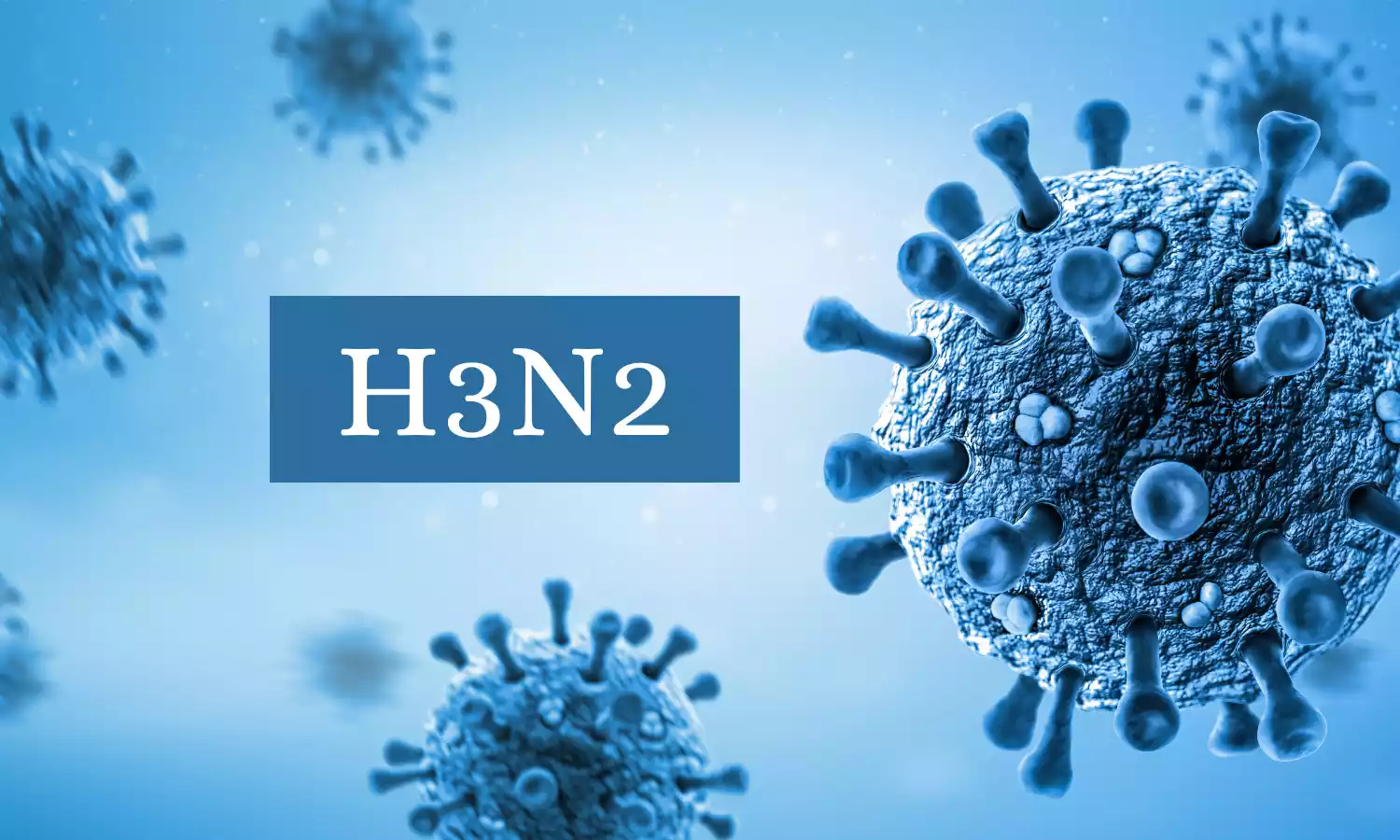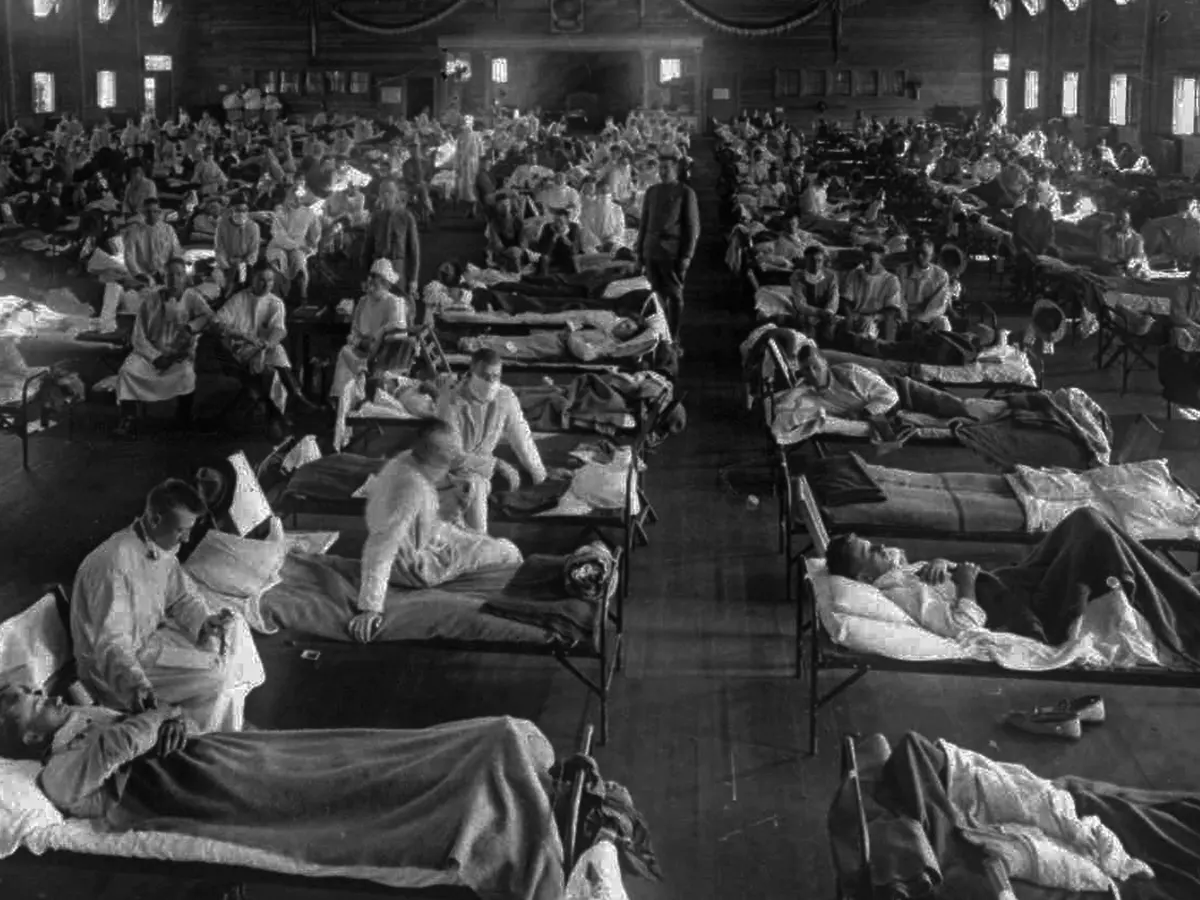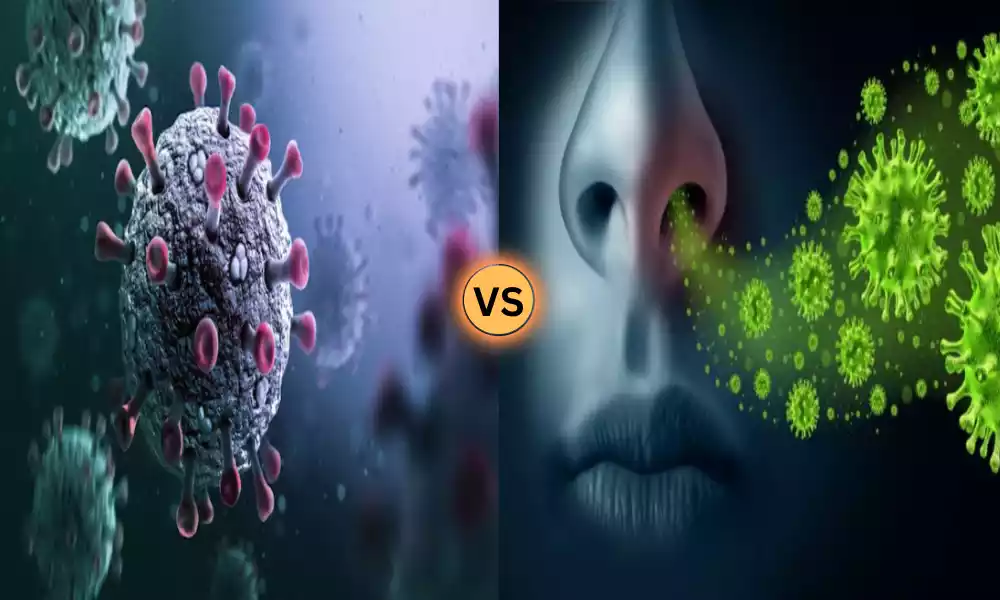H1N1 and H3N2: Influenza A viruses, primarily affecting the respiratory system, can be classified into different subtypes based on the combination of two main surface proteins: hemagglutinin (H) and neuraminidase (N). H1N1 and H3N2 are two significant subtypes of these viruses. H1N1, initially known for the Spanish flu pandemic in 1918 and later for the 2009 global outbreak, is marked by the pairing of Hemagglutinin 1 and Neuraminidase 1 proteins.
H3N2, on the other hand, emerged around the 1960s and is distinguished by the combination of Hemagglutinin 3 and Neuraminidase 2 proteins. Both subtypes can cause seasonal epidemics and vary in their transmission, virulence, and impact on different populations.
History and Evolution
History and Evolution of H1N1 and H3N2
H1N1:
- 1918 Pandemic (“Spanish Flu”): The most devastating influenza pandemic in modern history was caused by an H1N1 virus in 1918. It resulted in an estimated 50 million deaths worldwide, with one-third of the global population getting infected. Despite its nickname “Spanish Flu,” its origin remains uncertain.
- Subsequent Decline and Resurgence: After 1918, the H1N1 virus caused seasonal flu outbreaks but lost its pandemic potency. It circulated until 1957, when it was replaced by H2N2. Interestingly, H1N1 was absent from human populations from 1957 to 1977.
- 1977 Outbreak: The H1N1 virus made a sudden reappearance in 1977, primarily infecting individuals under 20. Genetic analyses suggested this strain was closely related to the 1950s strain, leading to speculation about a potential laboratory release.
- 2009 Pandemic: A new variant of H1N1 emerged in 2009, originating from pigs, leading to another pandemic. This strain was a reassortment of bird, swine, and human flu viruses. The World Health Organization declared it a pandemic in June 2009. By August 2010, over 1.4 billion people had been infected, causing between 151,700 and 575,400 deaths.
- Present Status: Post the 2009 pandemic, this H1N1 variant became one of the strains included in the seasonal flu vaccine, causing seasonal flu outbreaks but with reduced severity.
H3N2:
- Emergence in 1968 (“Hong Kong Flu”): The H3N2 virus emerged in 1968, resulting from an antigenic shift from the previously circulating H2N2 virus. The first reported cases were in Hong Kong, and within three months, it had spread worldwide. The estimated death toll ranged between 1 million to 4 million, making it less lethal than the 1918 pandemic but still considerably devastating.
- Evolution and Changes: H3N2 has been responsible for higher morbidity and mortality rates compared to other seasonal flu strains since its emergence. It’s known for its rapid mutation rate (antigenic drift), making it a challenge for vaccine effectiveness.
- Present Status: H3N2 continues to circulate as a seasonal influenza strain and, due to its high mutation rate, often demands updates in the annual flu vaccine to match its evolving nature.
The histories of H1N1 and H3N2 are testament to the dynamic and unpredictable nature of influenza viruses. Their ability to evolve and adapt poses ongoing challenges for public health officials and emphasizes the importance of surveillance, research, and vaccine development.
Definition of H1N1
H1N1 refers to a subtype of the influenza A virus, characterized by the combination of two main surface proteins: Hemagglutinin 1 (H1) and Neuraminidase 1 (N1). This subtype is known to infect humans and has been the cause of various flu epidemics and pandemics throughout history. Notably, H1N1 was responsible for the 1918 Spanish flu pandemic, which resulted in millions of deaths worldwide.

A different strain of H1N1 also caused a global pandemic in 2009, originating from a reassortment of bird, swine, and human flu viruses. Since then, this 2009 H1N1 variant has become one of the regular seasonal influenza strains, often included in the annual flu vaccine.
Symptoms of H1N1
Symptoms of H1N1 influenza (often referred to as “swine flu” when discussing the 2009 pandemic) are similar to those of other strains of seasonal influenza. Infected individuals may experience:
- Fever and chills: Typically, a sudden onset of high fever is observed.
- Cough: Often a dry cough.
- Sore throat.
- Runny or stuffy nose.
- Muscle or body aches: These can range from mild to severe.
- Headache.
- Fatigue or tiredness: Some people might feel unusually tired for several weeks.
- Gastrointestinal symptoms:
- Diarrhea
- Vomiting
- Nausea (Note: These are more common in children infected with H1N1 than in adults.)
- Shortness of breath or difficulty breathing (more severe cases).
- Chest pain or abdominal pain (more severe cases).
- Dizziness or confusion (more severe cases).
- Severe vomiting (more severe cases).
It’s essential to understand that while many people may exhibit mild symptoms, certain populations, such as the elderly, young children, pregnant women, and those with underlying health conditions (like asthma, diabetes, heart disease), are at a higher risk of developing severe complications from H1N1.
Definition of H3N2
H3N2 is a subtype of the influenza A virus, defined by the presence of two main surface proteins: Hemagglutinin 3 (H3) and Neuraminidase 2 (N2). Known to infect humans, H3N2 has been responsible for multiple flu epidemics since its emergence. It first appeared in 1968, resulting from an antigenic shift, and led to the “Hong Kong Flu” pandemic that year.

H3N2 is particularly noted for its rapid mutation rate, which often results in challenges related to vaccine effectiveness. Since its emergence, H3N2 has become a recurring strain in seasonal influenza outbreaks and is frequently incorporated into the composition of the annual flu vaccine.
Symptoms of H3N2
Symptoms of H3N2 influenza are similar to those of other strains of seasonal influenza. When infected with the H3N2 subtype, individuals may experience:
- Fever and chills: A rapid onset of high fever is commonly seen.
- Cough: Often a persistent dry cough.
- Sore throat.
- Runny or stuffy nose.
- Muscle or body aches: These aches can vary from mild to severe.
- Headache.
- Fatigue or tiredness: This can be profound and last longer than the other symptoms.
- Gastrointestinal symptoms (though they’re less common with H3N2 compared to some other flu strains):
- Diarrhea
- Vomiting
- Nausea
- Shortness of breath or difficulty breathing (especially in more severe cases).
- Chest pain or abdominal pain (more severe cases).
- Dizziness or confusion (more severe cases).
- Severe vomiting (more severe cases).
While the symptoms of H3N2 are largely consistent with other strains of the flu, it’s noteworthy that H3N2 has often been associated with more severe flu seasons, leading to higher hospitalization rates and deaths, especially among the elderly, young children, and those with certain underlying health conditions.
Comparison table of H1N1 and H3N2
Here’s a simplified comparison table of H1N1 and H3N2:
| Feature | H1N1 | H3N2 |
|---|---|---|
| Introduction | Subtype of influenza A virus | Subtype of influenza A virus |
| Major Pandemics | 1918 (“Spanish Flu”), 2009 | 1968 (“Hong Kong Flu”) |
| Origin of Major Outbreak | 1918: Unknown; 2009: Mexico & USA | 1968: Hong Kong |
| Affected Populations | 1918: Especially 20-40-year-olds; 2009: Younger populations | Predominantly older adults |
| Symptoms | Fever, cough, sore throat, body aches, fatigue, etc. | Similar, but with H3N2, severe seasons are more frequent |
| Antigenic Characteristics | Prone to mutations; Antigenic drift and shift | Prone to rapid mutations; frequent antigenic drift |
| Vaccine Incorporation | Regularly part of seasonal flu vaccines | Regularly part of seasonal flu vaccines |
| Severity | Can vary; 1918 strain had high mortality | Known for severe flu seasons; higher hospitalization rates |
| Transmission | Respiratory droplets, contact with contaminated surfaces | Similar to H1N1 |
| Treatment | Antiviral medications like oseltamivir | Similar treatments as H1N1 |
This table provides a broad overview, and further details can be derived from the specific sections we discussed earlier. Both viruses demonstrate the need for continuous monitoring and proactive healthcare measures.
Diagnosis of H1N1 and H3N2
Diagnosis of H1N1 and H3N2 involves detecting the presence of the specific viral RNA or proteins in respiratory specimens. The diagnostic approach for both subtypes is similar since they are both influenza A viruses. Here’s how they are typically diagnosed:
1. Clinical Presentation:
- Initial suspicion is often based on the clinical presentation and recent history of contact with confirmed cases or recent travel to areas with ongoing outbreaks.
2. Rapid Influenza Diagnostic Tests (RIDTs):
- These tests can detect influenza A viruses within approximately 15 minutes. They can’t distinguish between H1N1 and H3N2 (or other subtypes).
- RIDTs are less sensitive than other methods, so false negatives are possible.
3. Reverse Transcription Polymerase Chain Reaction (RT-PCR):
- RT-PCR is a highly sensitive and specific method for detecting and distinguishing between influenza A subtypes. It can differentiate H1N1 from H3N2.
- This test is the gold standard for confirming the presence of H1N1 or H3N2 in suspected cases.
4. Viral Culture:
- Viral culture involves growing the virus in a controlled environment, often using specific cell lines.
- This method is more time-consuming than RT-PCR and is often used for further characterization of the virus or for vaccine development rather than rapid clinical diagnosis.
5. Direct and Indirect Fluorescent Antibody (DFA and IFA) Tests:
- These tests identify the presence of viral proteins in respiratory specimens using fluorescent antibodies.
- They can detect and differentiate between influenza A and B but may require additional testing to differentiate between influenza A subtypes.
6. Serological Testing:
- This testing detects antibodies against influenza in the blood.
- It’s not typically used for early diagnosis but can be used for research, epidemiological studies, or to confirm past infection.
7. Point-of-Care Molecular Tests:
- These are newer tests that can provide results in approximately 20 minutes to an hour.
- They combine the speed of RIDTs with the increased accuracy of molecular methods.
8. Imaging:
- While imaging like chest X-rays or CT scans are not diagnostic for influenza, they can be used to identify complications such as pneumonia in hospitalized patients.
It’s essential to collect respiratory specimens correctly and in a timely manner for accurate testing. Specimens can include nasopharyngeal swabs, throat swabs, bronchoalveolar lavage, or tracheal aspirates.
Prevention and Vaccination
Prevention and vaccination are essential strategies to combat influenza, including H1N1 and H3N2 subtypes. Here’s how they can be approached:
Prevention:
- Hand Hygiene: Regularly washing hands with soap and water for at least 20 seconds. If soap and water are not available, using an alcohol-based hand sanitizer with at least 60% alcohol is recommended.
- Respiratory Etiquette: Covering the nose and mouth with a tissue or elbow when coughing or sneezing, followed by proper disposal of tissues and hand-washing.
- Avoid Close Contact: Staying away from people who are sick and avoiding close contact with them.
- Stay Home When Ill: If experiencing flu-like symptoms, it’s essential to stay home to avoid spreading the virus to others.
- Clean and Disinfect: Frequently touched surfaces, like doorknobs, telephones, and bathroom fixtures, should be cleaned and disinfected regularly.
- Avoid Touching Face: Try not to touch the eyes, nose, or mouth, as these are common entry points for the virus.
- Use of Face Masks: Especially in areas of high transmission or during outbreaks.
- Limiting Travel: During pandemics or significant outbreaks, avoiding non-essential travel to affected areas is advised.
Vaccination:
- Annual Flu Vaccine: The most effective way to prevent the flu is by getting vaccinated every year. The composition of the vaccine might change annually based on the predictions about which strains will be most prevalent.
- Types of Vaccines: There are several flu vaccine options, including:
- Trivalent vaccines (cover three viruses: H1N1, H3N2, and one type of influenza B)
- Quadrivalent vaccines (cover four viruses: H1N1, H3N2, and two types of influenza B)
- High-dose vaccines for older adults
- Live attenuated influenza vaccine (LAIV) – a nasal spray vaccine
- Effectiveness: Vaccine effectiveness can vary from year to year, depending on the match between the strains in the vaccine and the strains circulating in the community. Even if not a perfect match, the vaccine can still reduce the severity of illness and decrease the risk of complications.
- Who Should Get Vaccinated? Everyone six months of age and older should get a flu vaccine every season, especially those at high risk of complications, including:
- Children younger than 5 years old
- Adults 65 years and older
- Pregnant women
- People with certain chronic medical conditions like asthma, heart disease, and diabetes
- Health care workers and caregivers
- When to Get Vaccinated? Ideally, vaccination should be done before the flu starts spreading in the community. In the Northern Hemisphere, it’s best to get vaccinated by the end of October, but vaccination can still be beneficial later in the flu season.
Prevention through non-pharmaceutical interventions combined with annual vaccination offers the best defense against the influenza virus. It not only protects the individual but also reduces the spread of the virus in the community, helping to protect vulnerable populations.
Outbreaks and Pandemics
Outbreaks and pandemics of influenza have been recorded throughout history, with varying degrees of severity and global impact. H1N1 and H3N2, being subtypes of the influenza A virus, have been responsible for notable epidemics and pandemics in the 20th and 21st centuries.

H1N1 Outbreaks and Pandemics:
- 1918 “Spanish Flu” Pandemic:
- The deadliest pandemic in modern history.
- Estimated to have infected one-third of the world’s population.
- Death toll estimates range between 50 million and 100 million.
- Particularly high mortality rates among healthy adults aged 20-40, as well as the elderly and children.
- 2009 H1N1 Pandemic:
- First identified in Mexico and the United States.
- Spread to over 214 countries.
- Estimated 1.4 billion people were infected globally.
- Worldwide, over 18,000 deaths were reported to the World Health Organization (WHO), but the actual number is believed to be much higher.
- Different from the usual seasonal flu, as it affected younger populations more severely.
H3N2 Outbreaks and Pandemics:
- 1968 “Hong Kong Flu” Pandemic:
- Emerged in Hong Kong and spread globally.
- Estimated to have caused 1-4 million deaths worldwide.
- Responsible for significant morbidity and mortality, especially among the elderly.
- Seasonal Epidemics:
- H3N2 has been a recurrent strain causing seasonal flu epidemics since its emergence in 1968.
- Known for its rapid mutation rate, which sometimes leads to vaccine mismatches, making certain flu seasons particularly severe.
Factors Contributing to Outbreaks and Pandemics:
- Antigenic Drift:
- Minor changes in the virus due to mutations, leading to new strains.
- Can result in seasonal epidemics if the population has limited immunity to the new strain.
- Antigenic Shift:
- A significant change in the virus resulting from the reassortment of genetic material, often due to the co-infection of a host with two different influenza viruses.
- Can lead to pandemics as the resulting new strain might be significantly different from previous strains, so the population has little to no immunity.
- Transmission Dynamics:
- Influenza is primarily spread via respiratory droplets, but can also spread through touching contaminated surfaces.
- High transmissibility in crowded settings, such as urban centers, public transport, and gatherings.
- Globalization:
- Increased international travel facilitates the rapid spread of the virus across countries and continents.
H1N1 and H3N2 subtypes have caused significant outbreaks and pandemics in the past, highlighting the importance of global surveillance, preparedness, and swift public health interventions. Continuous research, vaccine development, and global cooperation are crucial to manage and mitigate the impacts of these viruses.
Current Situation
As of my last update in January 2022, I do not have real-time or post-January 2022 data regarding the current situation of H1N1, H3N2, or any other specific events. I can provide you with a general framework on how to assess the current situation:
- Official Health Organizations: The World Health Organization (WHO), the Centers for Disease Control and Prevention (CDC), and other national health agencies regularly publish updates on influenza activity, strains in circulation, and other related data. Checking their websites or official publications would provide the most recent and accurate information.
- Local Health Departments: For a more localized perspective, local or regional health departments and agencies might provide information pertinent to specific areas or regions.
- News Outlets: Reputable news organizations will often cover significant health events or updates on influenza outbreaks, especially if they are causing substantial concern or have widespread effects.
- Vaccine Updates: Annually, there are updates on the composition of the flu vaccine based on the strains predicted to be most prevalent in the upcoming flu season. This information can give insights into which strains health experts believe will be most active.
- Epidemiological Data: Various platforms and tools track infectious diseases, including influenza, in real-time or near-real-time. These platforms can provide insights into current outbreaks, their locations, severity, and more.
To get the most current situation for H1N1, H3N2, or any other influenza strains, I would recommend visiting the websites of the aforementioned official health organizations or checking reputable news outlets.
Conclusion
H1N1 and H3N2 are both subtypes of the influenza A virus, responsible for significant outbreaks and pandemics in recent history. The 1918 H1N1 “Spanish Flu” pandemic remains one of the deadliest events in human history, while the 1968 H3N2 “Hong Kong Flu” pandemic also caused widespread illness and death. Both strains have shown the capacity to mutate, underscoring the importance of continuous surveillance, research, and vaccine development.
Although their symptoms are similar, their epidemiological impacts and the populations they affect can vary. Ensuring global preparedness and public health interventions are crucial to manage the potential threats these viruses pose.



